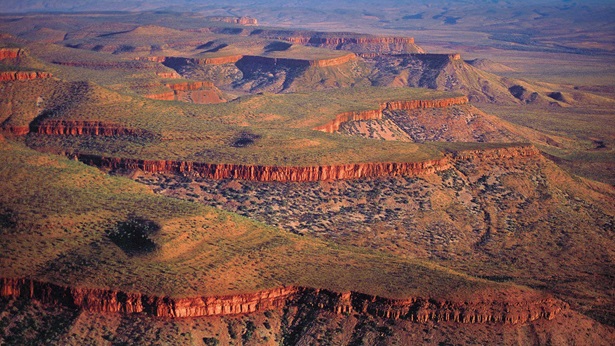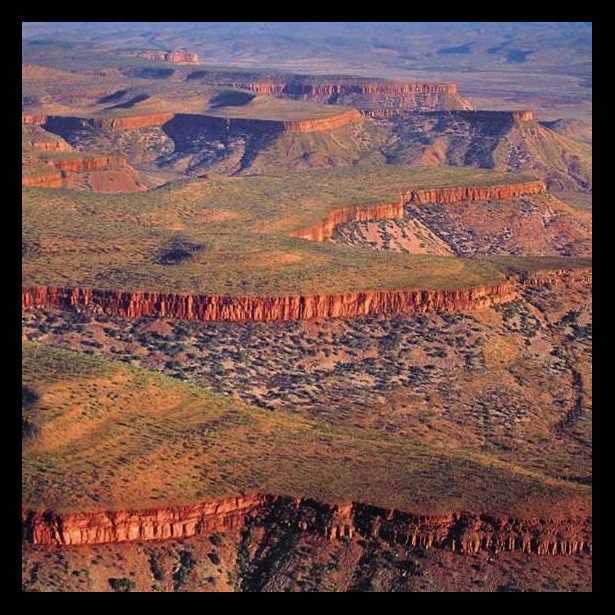The Modern Outback
Nature, people and the future of remote Australia
Overview
The Outback is the vast heartland of Australia. It includes places of exquisite beauty and wildness. It is an area of extremes, alternately lush and bountiful, harsh and inhospitable. The people and land of the Outback embody much that is most distinctive and characteristic of Australia. Yet while the Outback is quintessentially Australian, it is also a place of international consequence.
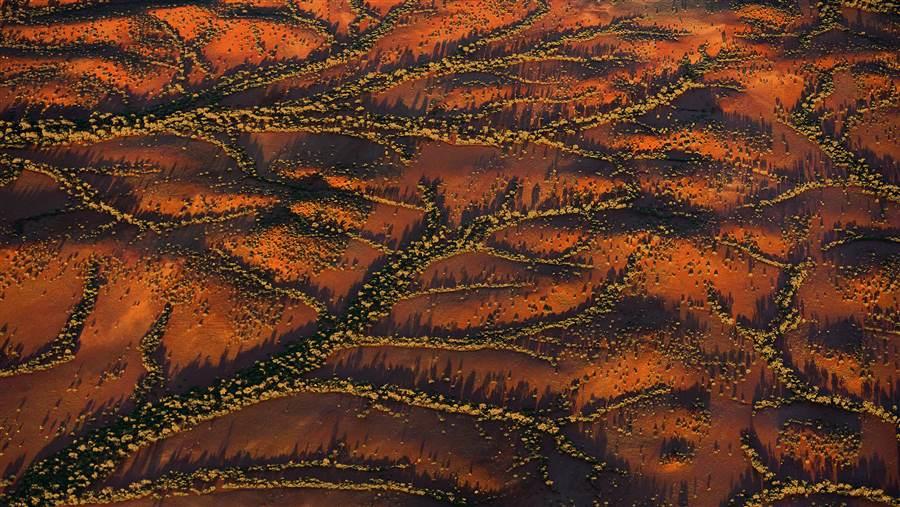 © Hugh Brown
© Hugh BrownThe Australian Outback comprises a rich tapestry of deeply interconnected landscapes that cover more than 70% of the continent. Ochre-coloured soils are a recurring feature across this vast landscape, as shown in this aerial view of a gully system in Western Australia’s Pilbara region.
The Outback has deeply interconnected threads of people and landscapes. Its natural environments support people, jobs, and economies, as well as some of the world’s most diverse and unusual plants and animals. The Outback’s environmental values merit the attention and concern of the nation and the world. However, some of these values are being lost, diminished, or degraded because of particular threats. Managing these risks more effectively, or removing them entirely, would allow for significant progress in ongoing efforts to maintain the environmental, natural and cultural values of the Australian continent as a whole.
The Modern Outback: Nature, people and the future of remote Australia explores four intertwined themes:
- The natural values of Outback Australia and their national and global significance.
- How the Outback functions and the character of its ecology.
- How nature underpins Outback lives and livelihoods.
- The many threats the Outback is facing that are degrading, or may soon degrade, its extraordinary value.
Although this study is about conservation, its focus is broader than national parks and threatened species. Under consideration is how Australia can create a ‘modern Outback’ while maintaining the natural integrity of its diverse regions. The paper discusses practical approaches that are already improving development and conservation outcomes, and that can be increased in size and scale.
This effort represents the first major attempt to focus on the Outback as a coherent entity and to confirm it as the living heart of Australia and a place of international significance.
A real place with real needs
The Outback is a vast area spanning 5.6 million km2 and covering more than 70 percent of the Australian continent. By way of comparison, it would encompass more than half of the United States or Europe.
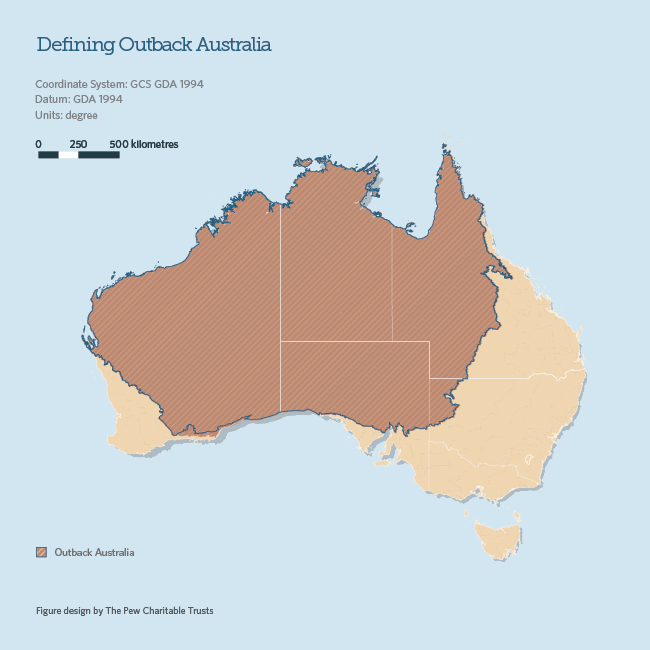
The Outback Papers define the Australian Outback as, encompassing all of the Northern Territory, most of Western Australia, South Australia, and Queensland, and the north-western corner of New South Wales. Yet this area has less than 5% of the nation’s population.
The concept of the Australian Outback has long been embodied in the mythology, spirit and iconography of Australia. But it is much more than a symbol or romantic notion. It is a distinct place – a coherent region that can be defined geographically.
The Outback is markedly different from the more settled parts of Australia. It has a consistent set of characteristics, values, and challenges: remoteness from major population centres, low population density, largely unmodified natural environments and relatively infertile soils.
Australians, and much of the world, have long-celebrated many individual parts of the Outback, including Kakadu, Uluru, the central deserts, the Kimberley region and the Lake Eyre Basin. However, these sites have a context and an interconnection, and it is this entirety that forms the Outback.
The Outback’s limited development, general remoteness from cities, and low population density are dictated by the environment, in particular its infertile soils and its seasonal or annually erratic rainfall. Most of the Outback has markedly lower rates of plant productivity than in Australia’s more settled temperate areas. As a result, much of its population comprises small and scattered communities, and its environments have therefore remained relatively intact. Also, because the land has had limited potential for commercial enterprises, large areas have remained under Aboriginal management and, more recently, exclusive Aboriginal possession within Australian as well as Indigenous laws.
Outback environments may be varied, but they are parts of the same overall fabric – sharing the same fundamental ecological processes and management challenges. A pastoralist in Queensland’s Channel Country faces many of the same issues as an Indigenous ranger working on country in Arnhem Land in the Northern Territory, or a national park manager in Western Australia’s remote Kimberley region. (See Table 1.)
A place of national and international environmental significance
The population of the world is 7.2 billion people. Most of the globe’s land surface has been modified from its natural state for agriculture, intensive grazing, plantations, industry and urban centres.
Only a small number of large natural areas remain on Earth … the rapidly diminishing wildlands of the Amazon basin; the boreal forests and tundra of Canada, Alaska and Siberia; the Sahara; and the Australian Outback.
A recent global analysis, The Last of the Wild, by the Wildlife Conservation Society and the Center for International Earth Science Information Network, highlighted the fact that only a small number of large natural areas remain on Earth. These are the places of relative wilderness, where ecological processes function normally and movements of wildlife remain largely, or wholly, unfettered by the fragmentation of habitats. These places are likely to endure as strongholds for biodiversity. They include the rapidly diminishing wildlands of the Amazon basin; the boreal forests and tundra of Canada, Alaska and Siberia; the Sahara; and the Australian Outback.
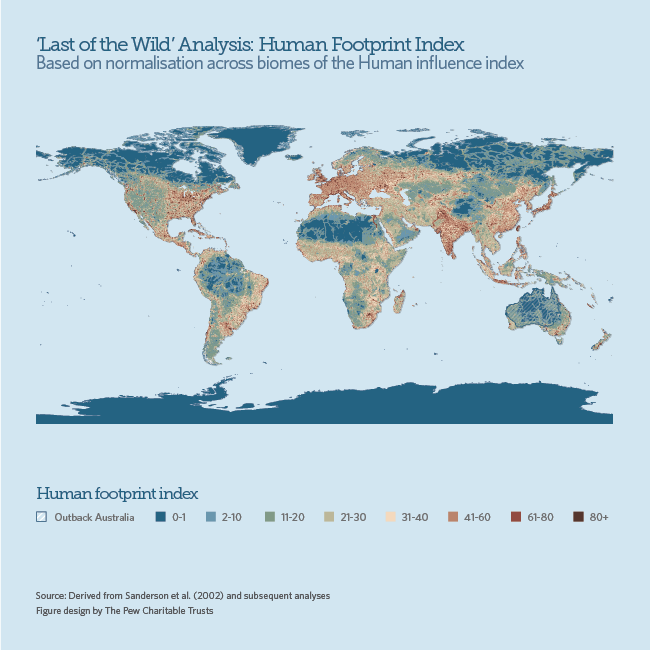
In a global context, Australia is significant for biodiversity: its many plants and animals are highly distinctive, with a high rate of endemism arising from its long isolation as a landmass. Of an estimated 11 million species worldwide, about 570,000 are native to Australia. Consequently, it is one of 17 ‘megadiverse’ countries – those with exceptional biodiversity – and along with the United States, is one of only two developed countries that share this designation.
Most Australian terrestrial species can be found nowhere else on Earth. For example, more than 80% of Australia’s mammals, reptiles, frogs, and plants, and about 70% of its insects, live only on this continent. Much of this biodiversity is restricted to, or most secure in, the Outback.
In addition, the Outback has the world’s largest remaining areas in natural condition for three global biomes:
- Tropical and subtropical grasslands, scrublands and savannas.
- Deserts and xeric shrublands.
- ‘Mediterranean-type’ forests, woodlands and scrub.
The Outback has the largest remaining intact tropical savanna on Earth, covering nearly 2 million km2 across northern Australia. The Outback’s 3 million km2 of deserts are among the least modified in the world, and, at 160,000 km2, the Great Western Woodlands in the south-west of the Outback, around Kalgoorlie, is the largest remaining woodland habitat in the world’s temperate Mediterranean climate zones.
The Lake Eyre Basin covers almost one-sixth of the continent and is the world’s largest internally draining river system. The drainage basin has one of the few free-flowing arid river systems remaining on Earth. The 1.7 million km2 Great Artesian Basin – the world’s largest groundwater basin – underlies much of the eastern half of the Outback. Offshore, the coastal seas of the tropical north and north-west comprise some of the world’s least disturbed coastal marine environments.
Six Outback areas are recognised internationally for their biodiversity significance and are listed as World Heritage sites. Eight Outback sites are listed as wetlands of international importance.
The nature of the Outback
The climate of the Outback is marked by two major features: in northern Australia, a relatively high rainfall driven by regular annual monsoonal (wet-dry) influences; and in central Australia, a relatively low and highly erratic rainfall for which spells of dry years are punctuated by irregular episodes of major rainfall events. The latter phenomenon creates ‘boom–bust’ environments to which many plant and animal species have adapted.
Outback vegetation varies broadly, ranging from dense rainforests to gibber (stony) deserts and salt pans almost devoid of plants. However, a small number of vegetation types dominate extensive areas and characterise the Outback:
- Tropical savannas and open eucalypt woodlands, with a dense and tall grass layer, occupy most of monsoonal northern Australia.
- ‘Hummock’ grasslands, dominated by a highly diverse set of spinifex species, are the major vegetation type across the vast sweep of arid and semi-arid Australia.
- Acacia (wattle) formations occur across extensive arid and semi-arid areas.
- Low shrublands, made up mostly of bluebush and saltbush species, grow in heavier soils, most notably those of the Nullarbor Plain and parts of northern South Australia.
- Tussock grasslands occur across extensive areas of blacksoil plains at the southern fringe of the monsoonal tropics, in coastal floodplains of northern Australia and in alluvial flood-out areas of the Channel Country and Lake Eyre Basin.
For a predominantly dry land, there is a surprisingly high diversity of wetland environments, with markedly different patterning and composition in monsoonal areas compared with arid and semi-arid areas. These range from tiny mound springs in central deserts, fed by artesian waters, to broad seasonal wetlands covering hundreds of thousands of hectares during the wet season in northern Australia. In the Outback, where water is usually the main limiting resource for life, these wetlands are often fundamental to maintaining wildlife populations and the productivity of whole landscapes.
Many plant and animal species occur extensively across the Outback. Others have very narrow ranges and are highly habitat-specific. Some habitat types and regions have particularly high richness or concentrations of species found only in small areas. For plants, there are important centres of endemism in south-western Australia (in an area that partly overlaps the Outback), the Kimberley, the western Arnhem Land plateau and Cape York Peninsula (particularly the Iron and McIlwraith ranges). Regionally important endemic-rich areas also exist in the central ranges.
A network of healthy ecological processes underpins the natural world of the Outback, forming the innate machinery that connects living and nonliving things and keeps nature robust. These processes include fire, flood and drought, and the movement of nutrients, wildlife and water across the landscapes. Overarching all of these are the characteristics of the land: its climate, nutrients and geography.
People in the Outback
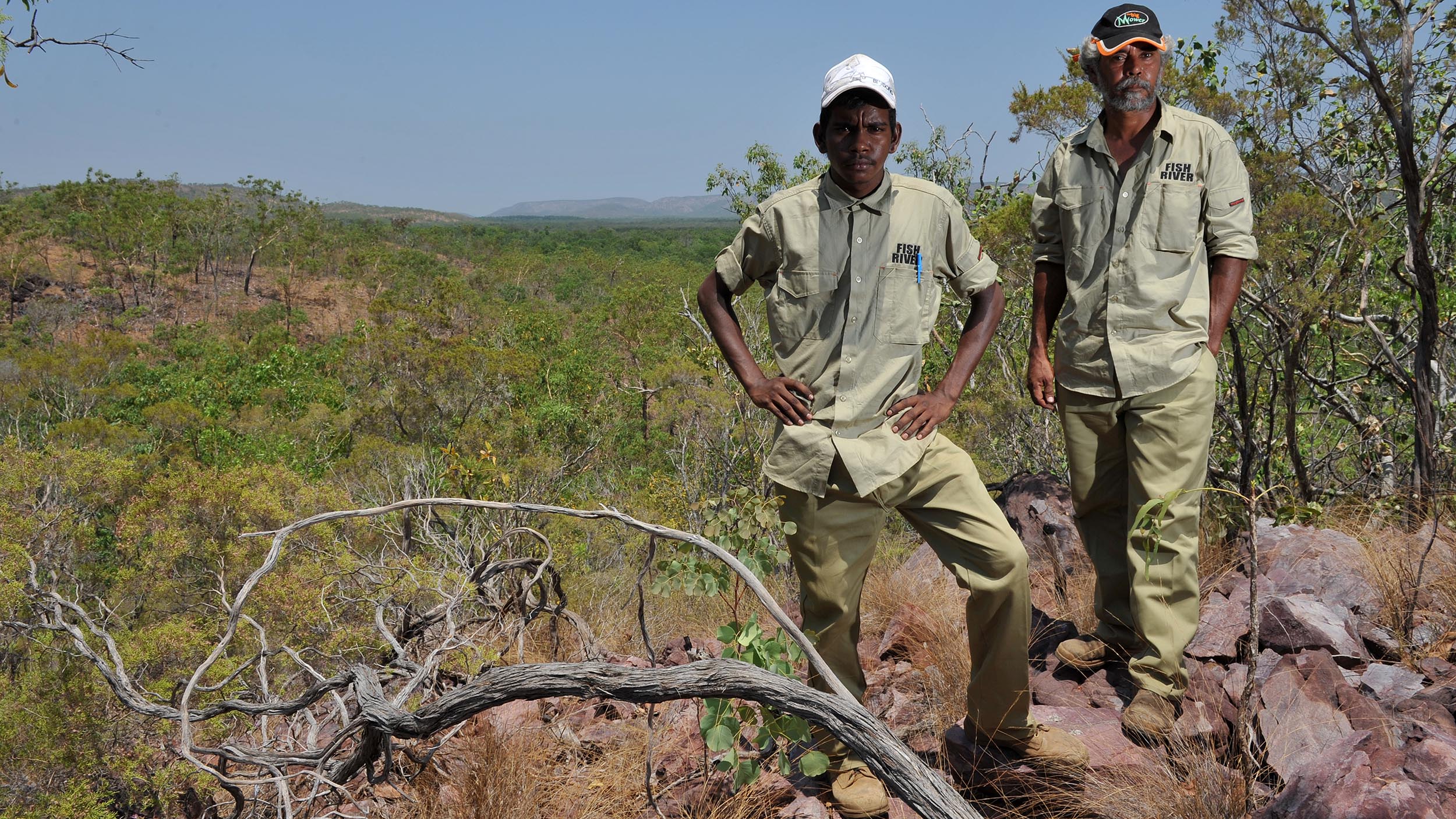 © Indigenous Land Corporation
© Indigenous Land CorporationFish River Rangers Desmond Daly, left, and Jeff Long help manage the 178,000-hectare Fish River Station in the Northern Territory for conservation and cultural heritage. The former cattle property was purchased through a ground-breaking partnership between the Indigenous Land Corporation, The Nature Conservancy, The Pew Charitable Trusts and the Australian Government.
A defining feature of the Outback is its sparse human population. Although it covers nearly three-quarters of the continent, the Outback supports only about 800,000 residents – less than 5% of the Australian population. Outside Darwin and a few major Outback towns, the population density of less than 0.1 person per km2 represents an extremely low figure compared with the global average population density of 50 people per km2. Aboriginal people make up about one-quarter of the Outback’s population.
Although it covers nearly three-quarters of the continent, the Outback supports only about 800,000 residents – less than 5% of the Australian population.
There are few cities or large towns in the Outback. Some are residential bases for major mining ventures and function as largely temporary pockets of affluence surrounded by huge regions with few people and meagre economies. There are also about 1,200 small Indigenous communities, of which almost half have a population of fewer than 100 people.
The Outback and its residents face many social, economic, and environmental challenges, largely as a result of patchy social and economic foundations. In part, the Outback operates as a colony from which natural resources are exploited and usually exported elsewhere for processing. Mining and government services, including support for natural resource management, dominate the overall economic output of the Outback. However, tourism, fishing, pastoralism, conservation and Indigenous art industries are more dispersed and support a greater number of communities and individuals outside of the cities and major towns.
The Outback under pressure
 © Stephen Zozaya/Invasive Animals Cooperative Research Centre
© Stephen Zozaya/Invasive Animals Cooperative Research CentreMany invasive pest animals cause significant damage to the nature of the Outback. Cane toads were introduced from central America in an attempt to control pests in sugar cane crops. However, they poison many native predators, such as quolls and goannas, which eat them.
Some components are awry in the Outback’s ecological systems. Even in areas remote from signs of people, some native plant and animal species are in decline and others have already disappeared. In many places, the thin lens of topsoil has been spent and the land’s potential productivity diminished.
The Outback faces two types of threats: those from extensive degradation and more localised but destructive ones caused by intensive industrial and agricultural projects. Most of the pervasive degrading threats relate to introduced invasive species and changes in fire management regimes. Across vast areas of the Outback, the intricate patterns and processes of fire management by traditional owners have been lost or withdrawn. Much of the land now burns extensively and without purpose or finesse. Feral animals occupy almost all the Outback, and noxious introduced weeds affect conservation and production values in many regions.
Fire, invasive species, and weeds occur broadly across the Outback’s landscapes, without respect to state or other boundaries, and affect wildlife as well as cultural and economic values. These pressures are now entrenched and will not be remedied by the local actions of one group with funding that lasts only a few years. To manage these threats, better ways of supporting people working on country are needed. This requires strategic approaches such as long-term security of funding and collaboration among a wide range of organisations.
The Outback is facing two types of threats: those from extensive degradation, and more localised but destructive ones caused by intensive industrial and agricultural projects.
In some Outback districts, major projects – such as intensive horticulture in the Ord River area and the substantial mining industry in the Pilbara – have transformed environments. In a region as immense as the Outback, it may seem that small pockets of intensive localised development would not affect the natural fabric of the Outback as a whole. However, activities that alter ecosystem processes may have damaging impacts on nature and other economic concerns that extend well beyond the project site. Such actions include extracting water from rivers and aquifers for irrigation and industry, as well as the large-scale removal of bushland for strip-mining or agriculture.
Overarching these threats is the risk posed by global warming. Parts of the Outback are experiencing an increase in the number of days with very high temperatures, making an already hot place even less habitable for people and wildlife as well as potentially increasing fire risk.
More people caring for country
In a crowded world, the Outback as one of the rare places that can provide an extraordinary sense of space and of nature relatively untouched by human hands. This depiction, while compelling and refreshing, is also misleading.
Aboriginal people settled the northern Outback more than 50,000 years ago, spreading to the arid lands at least 35,000 years ago. Over millennia, these traditional owners developed an intimate understanding of their homeland, its nature and seasons, including its relationship with, and reliance on, fire for regeneration and preservation.
National policies and economies over the last 150 years have led to an altered demography and pattern of population dispersion in many Outback landscapes. Much of the Outback has fewer people inhabiting and actively managing the land than at any time over the past 50,000 years. Because too few people are tending these lands, parts of the Outback are faltering. Fewer than 1 in 20 Australians lives in the Outback, and fewer still share the responsibility of managing the millions of square kilometres of country.
Much of the Outback has fewer people inhabiting and actively managing the land than at any time over the past 50,000 years.
Many Outback landscapes would benefit from more people living and working in them. More land managers would support better management of deeply entrenched threats – particularly fire, feral animals and noxious weeds – and wider implementation of conservation programs that maintain biodiversity, protect the general health of the environment and benefit Outback people and their economies.
Establishing a modern Outback
The Outback is of special value and significance, nationally and internationally. Fundamental to protecting its wildlife and human societies is establishing a modern Outback that values and respects its nature and sustains its people.
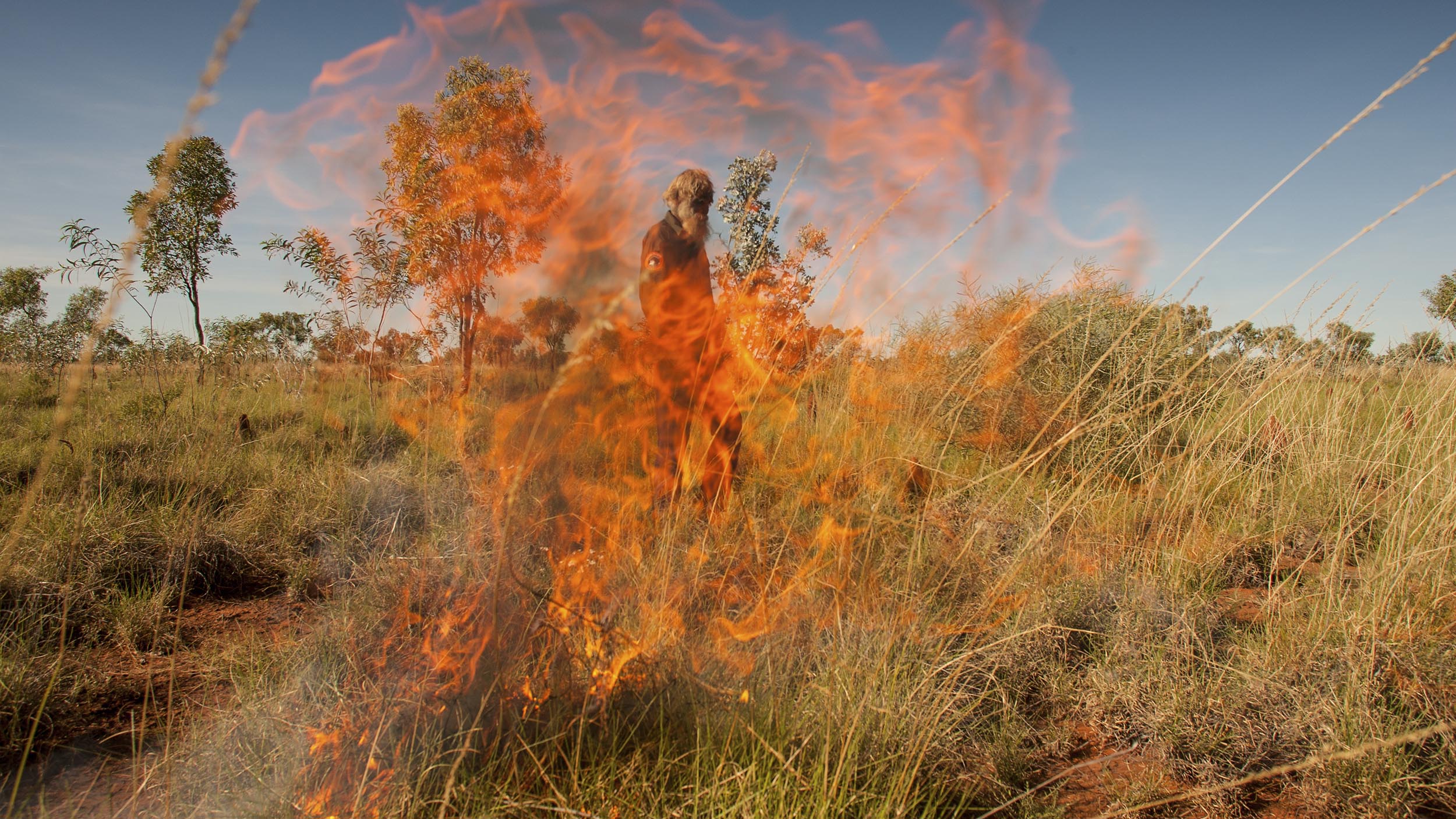 © Glenn Campbell
© Glenn CampbellIndigenous Ranger Benny Jabbalari conducts a controlled burn in spinifex country in the Northern Territory’s Tanami Desert. The Tanami comes under two Indigenous Protected Areas, with rangers working to manage threats such as wildfires, weeds and feral animals.
From its unsettled present-day position, the Australian Outback has a range of potential futures. These may be realised by default and inaction or by deliberate choice. This choice is real and urgent, but to date it has been neglected. In the absence of deliberate choice, ad hoc changes are chipping away at what is distinctive about the Outback and are undermining opportunities to choose a sustainable future.
One possible future – more or less the default – would result from ongoing inattention or patchy engagement with little strategic investment. This way would lead to continued environmental degradation, a reduction in the Outback’s importance to the national economy and character, and, in many regions, failing communities. Diminished, too, would be the Outback’s international significance.
Another imagined future would be to treat the Outback as a land ripe for unfettered development. The landscape would be divided into exploited and conserved or neglected sectors. An economy highly reliant on intensive agriculture and mining would seek to transform the Outback, with the logistical and environmental constraints of such industrialisation overcome through government subsidies. This approach may create brief economic growth in a few districts, but in the long-term it would cause irredeemable loss to those values that make the Outback so distinctive and important.
In the absence of deliberate choice, ad hoc changes are chipping away at what is distinctive about the Outback and undermining opportunities to choose a sustainable future.
There is a third vision of the future that recognises the existing inherent value in the Outback and supports development that adapts to and works within the environmental and other constraints presented by remote and dry lands. This approach acknowledges that the Outback must pay its way and that it is in the national interest to further develop some areas.
However, the scale of such efforts needs to be carefully managed within the landscape. This future path must, above all else, be sustainable, without damaging the broader ecological function and health that defines and underpins the Outback. Such development must also contribute more specifically to local communities and to broader regional land management, providing the longer-term security for land management activities to grow and function effectively.
Such changes are already happening in many districts. Aboriginal ranger groups, working in Indigenous Protected Areas and parks on Aboriginal-owned lands, manage more than 50 million hectares of the Outback – an area more than twice the size of the state of Victoria – using a combination of modern and traditional methods. The growth of Indigenous Protected Areas over the past 10 years, and their beneficial impact on the environment and local communities, has been one of the success stories in the development of remote Australia, particularly for Aboriginal communities.
In substantial parts of the Outback, some leases of crown land by grazing enterprises or private individuals are no longer viable as commercial operations. However, some existing leaseholders and new owners – conservation organisations, Aboriginal communities, tourism operators, and individuals – are now using these pastoral leases for enterprises such as tourism and conservation, which can provide better land management and stronger economies in remote areas. These activities currently have an ambiguous legal foundation, as they occur under leases that mandate pastoral use. Further policy changes will be needed to enable the development of jobs, local economies and conservation benefits on a much greater scale across lands currently held as pastoral leases.
Those best positioned to lead the creation of a modern Outback are the people who live in, value, and actively care for this vast landscape.
A sustainable future for the Outback, built on a firm foundation of government policy and public good, is achievable and desirable. Such a future would maintain, and benefit from, the existing natural and cultural values of the Outback.
Much in the old Outback has stagnated over the course of decades of neglect and disregard. There is now a compelling opportunity for the modern Outback – the future Outback – to be shaped more deliberately and thoughtfully. In this respect, the Outback represents one of Australia’s greatest conservation opportunities.
Those best positioned to lead the creation of a modern Outback are the people who live in, value, and actively care for this vast landscape. Connecting, supporting and resourcing these stewards, both indigenous and non-indigenous, provides the best opportunity to protect Australia’s largest natural wonder for the benefit and enjoyment of future generations.
Such a process must involve a dialogue. The intent of the first Outback Paper, and The Outback Papers series, is to contribute to that discussion and to encourage Australia’s leaders and communities to deeply consider this special place and its future.
There is now a compelling opportunity for the modern Outback – the future Outback – to be shaped more deliberately and thoughtfully. In this respect, the Outback represents one of Australia’s greatest conservation opportunities
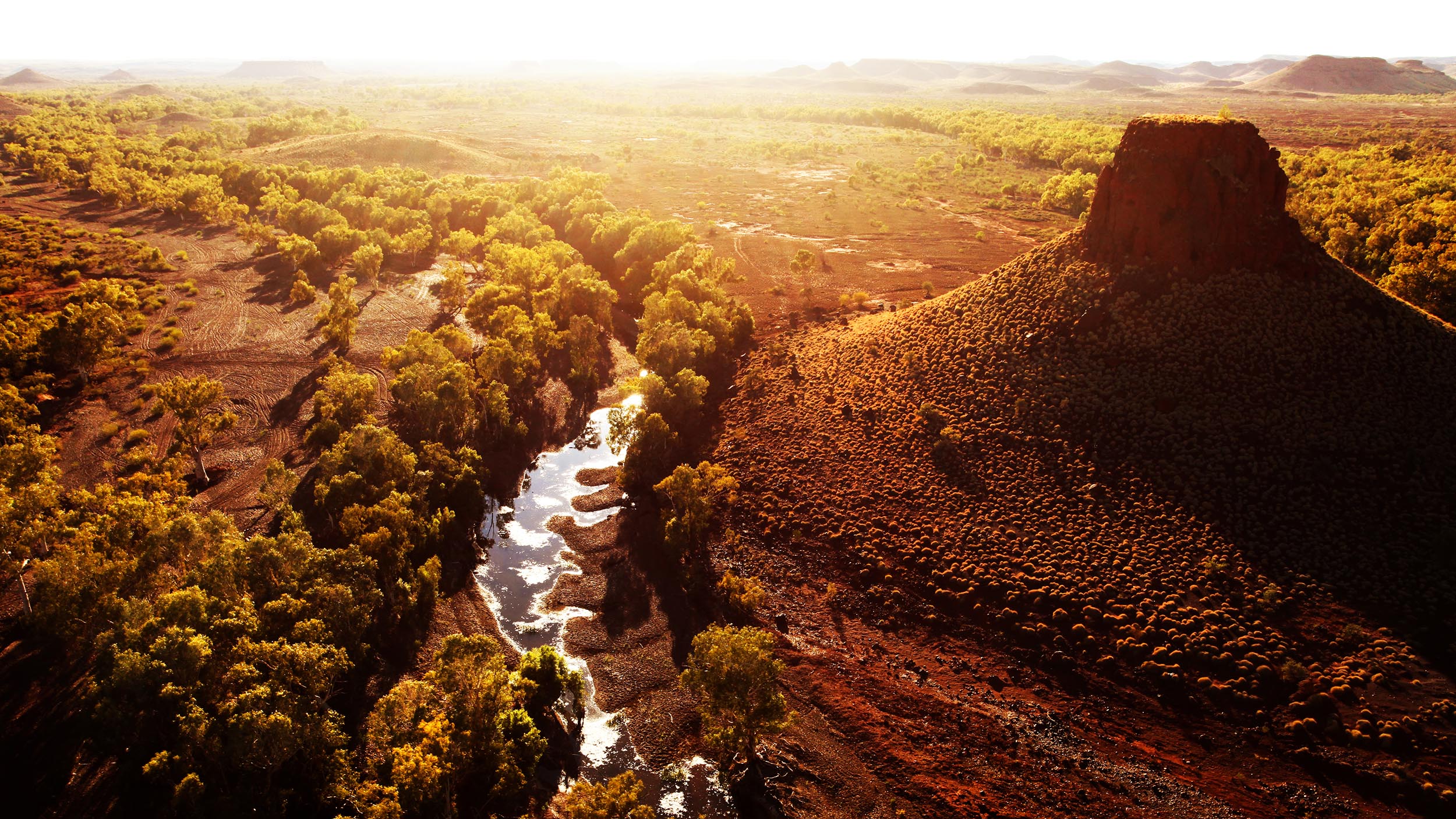 © Dan Proud
© Dan ProudThe sun sets behind Pannawonica Hill and the Robe River in Western Australia’s Pilbara region. Across much of the Outback, watercourses such as this ephemeral river, which is reduced to a series of permanent pools during the dry season, serve as important refugia for native animals and harbour distinctly different plant and animal communities.
Read the full brief (PDF)
Read the full report (PDF) (241 p.)
TABLE 1
Summary of Contrasts Between the Outback and Other Parts of Australia
Feature |
The Outback |
Non-Outback |
|---|---|---|
Area |
5.6 million km2 (73% of Australia’s land area) |
2.1 million km2 (27% of landmass) |
Geography |
Continental core and remote coast |
Mostly near-coastal periphery |
Topography |
Mostly flat, with isolated low weathered ranges |
Includes the long spine of Australia’s tallest mountains |
Climate |
High to extreme variability; long dry periods interspersed with shorter periods of high rainfall |
Less variability and less extreme |
Soils |
Most highly infertile |
More fertile |
Natural productivity |
Very low or highly seasonal in wet season, boom and bust cycles, annually or irregularly |
More productive; rainfall and growth less seasonal |
Cover of native vegetation |
Mostly woodlands, hummock grasslands and shrublands; >95% intact |
Originally mostly extensive areas of diverse forests, now >30% cleared |
Rivers |
Mostly free-flowing, <5% of water taken for exploitative use |
Most rivers are dammed; typically >20% of water diverted for exploitative use |
Population |
0.8 million |
21.9 million |
Population density |
0.14 people per km2 |
10.4 people per km2 |
Indigenous population |
25% of population |
<5% of total population |
Indigenous land tenure |
>20% of land area owned by Indigenous people, with native title rights over extensive additional areas |
<2% of land area owned by Indigenous people, and limited additional areas for which native title rights apply |
Economy |
Relatively limited: intensive mineral production, extensive pastoralism, government services and tourism |
More diverse: manufacturing, mining, horticulture, forestry, tourism, finance, communications, technology and government services |
APPENDIX
Outback Characteristics Provide the Framework for Crafting a Sustainable and Modern Outback
The Australian Outback is at a crossroads. For Australia and for the world, a positive future must be crafted for this irreplaceable natural treasure.
Outback element |
Guidance from this characteristic for a sustainable Outback future |
|---|---|
The Outback is of international significance. |
We need to see and manage the Outback as a coherent entity, because its worth is greater than the sum of its iconic components. In a world of diminishing nature, the Outback will be increasingly valued at a global scale. We should not jeopardise that value. |
There is little or no coherent planning or management across the Outback – it is more or less arbitrarily segmented. |
Management, planning, and governance will be effective and cost-efficient only when the Outback is recognised as a coherent entity. There is scope and need for far more substantial collaboration across jurisdictions and tenures . |
Some components of Outback biodiversity are declining. The threats are significant and existing management is insufficient. |
There is an urgent need for action to maintain the Outback’s values. The loss of individual components of biodiversity is likely to have further repercussions, because such losses will disrupt ecological processes. Current management approaches and effort are inadequate to protect environmental values. The challenge will be met only by enhanced collaboration,having more people actively managing the land, and large-scale and long-term strategic responses. |
Maintaining indigenous culture has much in common with, and is conducive to, effectively managing the land. |
The expanding network of Indigenous Protected Areas and Indigenous ranger groups provides an important basis for enhancing conservation management across the Outback, while also addressing critical social and economic challenges. |
Historic legacies of land tenure and use are a suboptimal foundation for the future. |
In parts of the Outback, current land tenure or use may be an ill-fitting legacy of historical factors. And in some places this land tenure or use may cause environmental detriment without delivering social or economic benefit. A more rational, considered and forward-looking consideration of land tenure, use and policy is required. |
In a dry land, water is a pivotal resource. |
Much of Outback ecology pivots on water, which is typically the primary contested zone for exploitation and disturbance. Given water’s critical role in processes underpinning the Outback’s ecology, management and planning should ensure that its exploitation is constrained within safe environmental limits. |
Climate change will exacerbate some existing challenges for Outback life. |
It will be necessary to maintain broad-scale connectivity across the landscape to allow species to move to different locations in response to changing climates. This is more likely to be achievable in the Outback than in more intensively settled parts of the world. Refuge areas will become of even more paramount importance, so need to be protected and well managed. In arid and semi-arid Outback areas, water resources may be subjected to increased pressure, so current use and management of those resources should be conservative. |
The economic fabric of Outback society is fragile and, in part, divided into rich and poor districts. |
Planning and management for the future of the Outback should be based on more secure, longer-term funding. Nodes of economic profitability in the Outback, such as major mining enterprises, should invest significantly in broader regional, social and environmental concerns aimed at achieving positive long-term impacts. |
Some iconic places in the Outback are well known and relatively well protected. |
Such locations provide flagships and critical core sites for conservation in the Outback, and they raise public awareness through research and tourism, but they will be inadequate by themselves to maintain Outback nature. Even these iconic areas will be diminished if their surrounds are not also protected. |
Refugia and nodes of species richness and endemicity (species found only in localised areas) are critical for biodiversity conservation, and particularly so in low-productivity and boom–bust systems. |
All areas that are critical for biodiversity need to be identified, protected, and managed appropriately – or else biodiversity will fail across large areas. |
Many animal species must disperse across the Outback to find food and water. |
Broad-scale habitat must be maintained across the spectrum of species whose survival in the Outback depends on dispersal. This particularly includes the protection from catchment to coast (or to inland terminus) for Outback river systems. The land-allocation model of nature being represented in fragments, even large fragments, is inappropriate for the Outback. Entire landscapes, and the ecological processes structuring them, need to be protected. Reservation is necessary but not sufficient: conservation areas also need to be appropriately managed. |

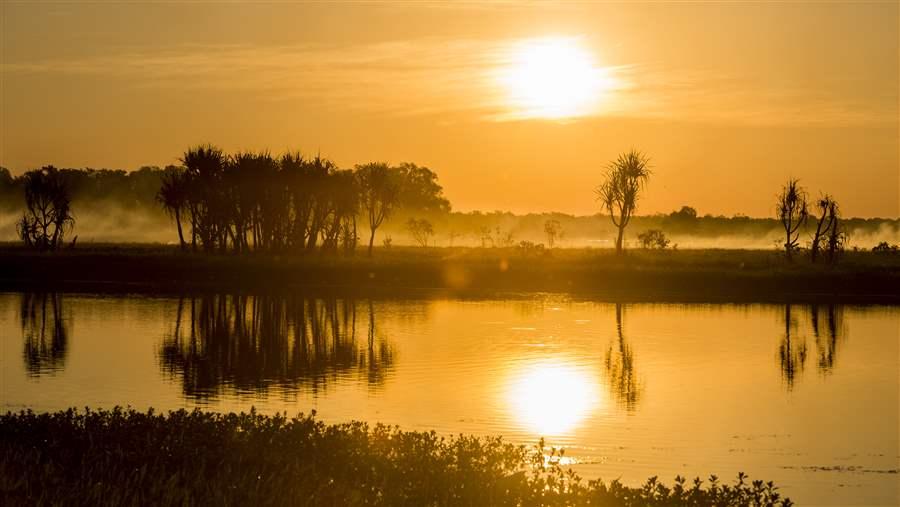
This video is hosted by YouTube. In order to view it, you must consent to the use of “Marketing Cookies” by updating your preferences in the Cookie Settings link below. View on YouTube
This video is hosted by YouTube. In order to view it, you must consent to the use of “Marketing Cookies” by updating your preferences in the Cookie Settings link below. View on YouTube
